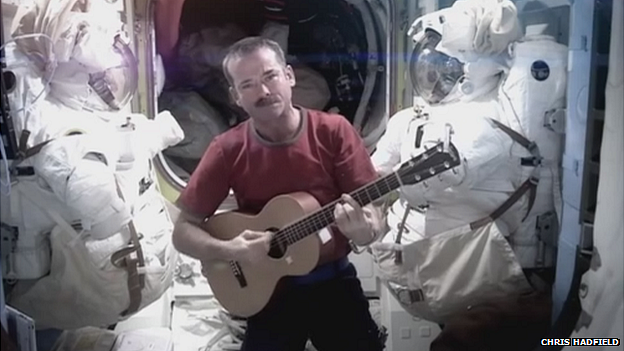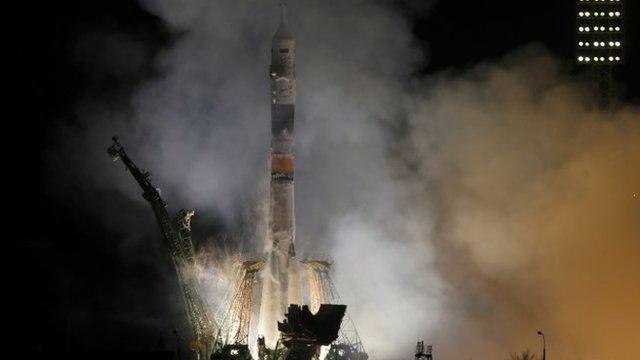Tweeting astronaut reveals Space tech secrets
- Published

Cdr Hadfield's version of Space Oddity became a global hit
Chris Hadfield has been an astronaut for 20 years, but it was only on his last mission that he gained worldwide fame.
His tweets from the International Space Station (ISS) attracted more than a million followers. And when he sung and played guitar to David Bowie's Space Oddity, it went viral around the net.
An edited version of the song accumulated more than 20 million YouTube views and led Cdr Hadfield to conclude that art and science had finally become bedfellows.
At the recent Ted (Technology, Entertainment and Design) conference in Vancouver, Cdr Hadfield was one of the star speakers.
The BBC talked to him afterwards and he revealed that getting a broadband connection to the ISS was similar to the slow progress towards connectivity on Earth.
"It's incremental, rather like wiring your house. First you get a telephone line and then you get a wireless network. It is incredibly complex to get internet on to the space station," he said.
"When I log on to my laptop, it goes through a wire in the space station, through to a conversion box that takes it to the outside of the station and converts it to an antenna signal that then goes up many thousands of kilometres from the Earth to a geo-satellite that takes it and converts it and sends it down to White Sands, New Mexico.
"That goes back through Maryland and back to White Sands and from there via a landline to Houston, and from there it is routed and all processed and comes through to mission control and on a desk in mission control is a computer that is hooked up to the internet."
The astronauts only get internet access for a few hours each day, and they share one thing in common with some of their Earth-bound friends and family.
"It is a bit slow and a bit unreliable," said Cdr Hadfield.
Two-way conversation
Net access was put on the space station primarily as psychological support for the astronauts, who are away from home for six months at a time. It enables them to email their families, and the ISS has video-conferencing capacities.
But connectivity had also "opened the door to communication in a way we have never seen before", said Cdr Hadfield.
"I'd been using Twitter for a few years prior to going to space, and Nasa had been making the space station more and more connected. While I was on the space station, we had a significant improvement in bandwidth almost to the point when you could stream live video," Cdr Hadfield told the BBC.
The bandwidth was sufficient for Twitter and it proved the perfect medium for communicating across the skies.
"It becomes a new two-way conversation from a place that almost nobody has ever been to and that proved immensely inclusionary and immensely powerful," he said.
He wasn't the first tweeting astronaut though - a tweet was sent from the ISS three year before his, although to a far more limited audience.
System shutdown
Astronauts have to be jacks of all trades when onboard the ISS, and perform a variety of tasks from cleaning the toilet to mending things that break to knowing how to stitch someone up if there is an accident.
They also have to be their own tech support.
"There is no IT guy. We upgrade and operate all the technology, We run maybe 50 laptops simultaneously on board, some connected to the wireless network, some not. We are constantly rebooting and upgrading and running experiments," Cdr Hadfield said.
And it is perhaps reassuring that even an organisation as technically advanced as Nasa experiences computer failures. One blighted his very first space flight.
"The main computers that run the whole thing started overwriting their own hard drives and shut down completely and the station was basically unable to control which way it was even pointing," he said.
"Fortunately we were docked to the shuttle, so we could take over until we were able to replace the hard drives."
Nasa has had astronauts on the ISS for the past 13 years, and it seems inevitable that less qualified people will also soon start to travel to space.
British entrepreneur Richard Branson is developing the world's first commercial spaceship, with 700 people, including actors Tom Hanks and Angelina Jolie, signed up to take the inaugural flight, possibly later this year.
Meanwhile others have already signed up for a one-way trip to Mars, slated to happen in 10 years' time.
So what does Cdr Hadfield make of the new horizons opening up in space?
"It is a natural extension of what we have been doing for the last 70,000 years on Earth, taking the best of our technology and using it to explore what we haven't seen yet and if that becomes an area that we want to go to live then we move there," he said.
"Just because it is in space it doesn't make it sacrosanct or wildly different."
He described man's journey to Mars as "just a slow, iterative expression of human curiosity".
While it would be technically possible to send a mission to Mars right now, it would also he said be "very dangerous and very expensive".
"We need to invent a few things yet," he said.
But when those early Martian settlers do set off, he has a few words of advice about the joys of being in space.
"You have a superpower. You can fly and do a thousands somersaults. And that never gets old, it is joyful, magic, so much fun."
"Being in space is one of those things in life that is better than you thought it would be."
- Published14 March 2014

- Published25 March 2014
